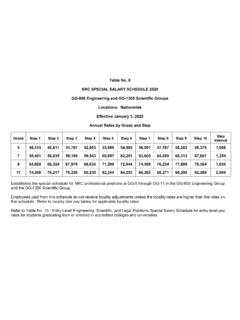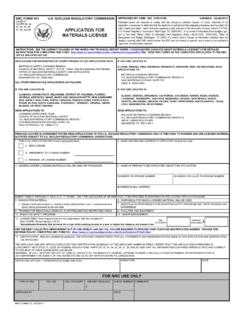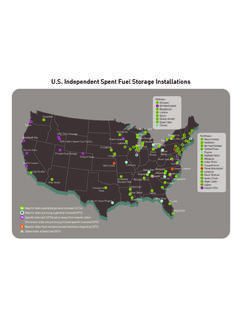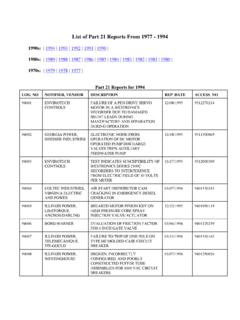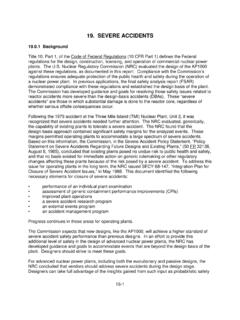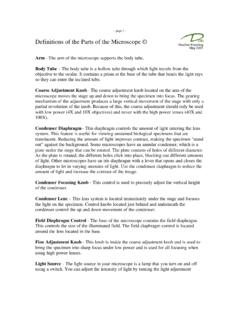Transcription of 10.4.3 Turbine Gland Sealing System 10.4.3.1 Design Bases
1 EPR FINAL SAFETY ANALYSIS REPORTTier 2 Revision 2 Page Gland Sealing SystemThe Turbine Gland Sealing System (TGSS) prevents the escape of steam from the Turbine shaft and casing penetrations and the glands of main steam stop and control valves. This System also prevents air leakage into the low pressure Turbine BasesThe TGSS performs no safety-related function and therefore has no nuclear safety-related Design TGSS is designed to meet the following functional criteria: Prevent atmospheric air leakage into the Turbine casings and minimize steam leakage from the casings of the high-pressure (HP) and low-pressure (LP) turbines. Collect leak-off steam from the glands of large Turbine valves in the leak-off steam piping. Return condensed steam to the condenser and exhaust noncondensable gases to the vent System of the main condenser evacuation System .
2 Provide flow to and from all HP and LP Turbine glands, assuming to 2 times the normal Gland clearances and the maximum allowable steam seal supply DescriptionFigure shows a flow diagram of the DescriptionDuring normal Turbine operation, steam passing through the HP Turbine shaft seals is throttled until it is only slightly above atmospheric pressure. It is then discharged from the inner steam space into a Sealing steam header, which is common to the shaft seals of the Turbine . The LP Turbine shaft seals, which are under vacuum, are supplied with Sealing steam from this header to prevent ingress of second steam space for Gland steam is located between the inner steam space of the HP and LP Turbine shaft seals and the atmosphere, which prevents the escape of seal steam to the atmosphere.
3 The Gland steam and any air entering this steam space through the shaft seals are normally drawn off by one of two exhaust fans via the condensate-cooled Gland steam Gland steam condenser is part of the condensate System that passes condensate through the tubing. Condensate produced by the Gland steam condenser is routed to the condenser through a steam EPR FINAL SAFETY ANALYSIS REPORTTier 2 Revision 2 Page steam side of the condenser can be bypassed in the event of Gland steam condenser failure. Any condensate produced is passed to the Turbine Building drains System via a loop line upstream of the Gland steam condenser isolation valve. This line also drains condensate that accumulates in the event of a tube leak in the Gland steam DescriptionTable provides the quality group and seismic Design classification of components and equipment in the TGSS.
4 Section describes how the guidance of RG is implemented for the Gland steam condenser receives steam and noncondensable gases from the TGSS and condenses the steam. The Gland steam condenser is integrated into the condensate System with condensate passing through the tubing. The drains from the Gland steam condenser discharge to the main condenser over a drip leg and through a steam Gland steam exhausters produce a slight vacuum in the Gland steam condenser to remove air and noncondensable gases that carry over into the Gland steam condenser with the leak-off steam from the shaft and noncondensable gases from the Gland steam exhausters are routed to the Turbine building air removal System (see Section ), where they are monitored for radioactivity and released into the nuclear auxiliary building ventilation TGSS piping provides steam for Sealing the shafts of the HP and LP turbines.
5 The System piping supplies the Sealing steam from the HP Turbine to the shaft seals of the HP and LP turbines and onto the Gland steam OperationPlant Startup and ShutdownDuring startup and shutdown, and in the low-load power range, steam from the auxiliary steam System is supplied to the TGSS through the seal steam supply valves as required to maintain the Gland steam header pressure. The motor-operated isolation valve fails as is. The pneumatically actuated pressure control valve fails to the position designated by the Turbine EPR FINAL SAFETY ANALYSIS REPORTTier 2 Revision 2 Page OperationDuring normal operation, enough steam escapes through the HP Turbine shaft seals that it can be used as a seal steam supply for the shaft seals of the LP turbines.
6 The excess steam escaping at higher loads is dumped to the main condenser through the seal steam leak-off valve. Leak-off steam from the seals of the main stop and control valves is also discharged into the TGSS header. The steam seal leak-off valve is a pneumatically actuated pressure control valve, which fails to the position designated by the Turbine EvaluationThe TGSS performs no safety-related functions and is not required to operate during or after an accident. The Design of the TGSS satisfies general Design criteria GDC 60 and GDC 64, related to the TGSS Design for control and monitoring of release of radioactive air and noncondensable gases discharged from the Gland steam exhausters are not normally radioactive during plant operation.
7 However, in the event of significant primary-to-secondary System leakage due to a steam generator tube rupture, it is possible for the seal steam to become contaminated resulting in the potential to discharge a radioactively contaminated Gland steam condenser receives steam and noncondensable gases from the TGSS and condenses the steam. Air and non-condensable gases are evacuated from the Gland steam condenser and discharged into the air vent System by exhaust fans. The exhaust flow is monitored for radioactivity as described in Section and discharged to the Nuclear Auxiliary Building ventilation System . and Testing RequirementsThe TGSS components are inspected during construction and functionally tested during plant startup. Refer to Section (test abstract #064) for initial plant startup test program.
8 Components of the TGSS are designed to permit periodic inspection and testing during plant operation. Components of the System are monitored during operation to demonstrate satisfactory functioning of TGSS RequirementsThe following TGSS parameters are monitored during plant operation: Steam seal header temperature. Steam seal header pressure. Gland steam exhauster EPR FINAL SAFETY ANALYSIS REPORTTier 2 Revision 2 Page Gland condenser outlet temperature. Gland condenser Fil





